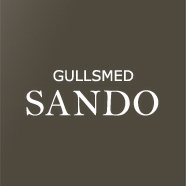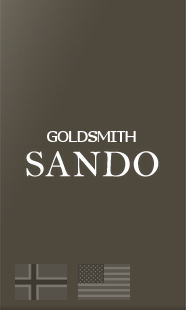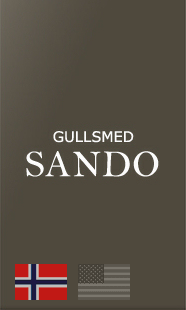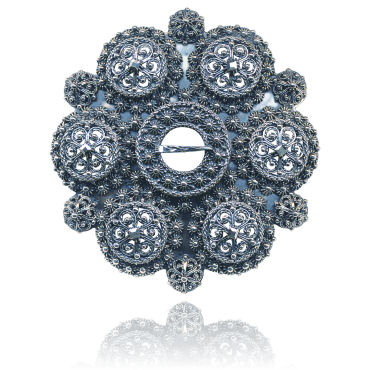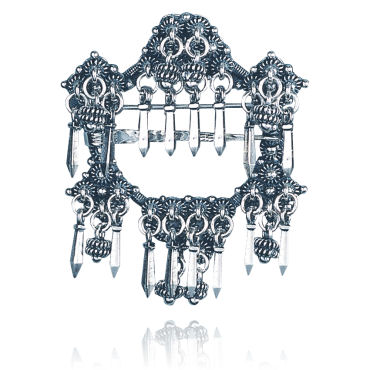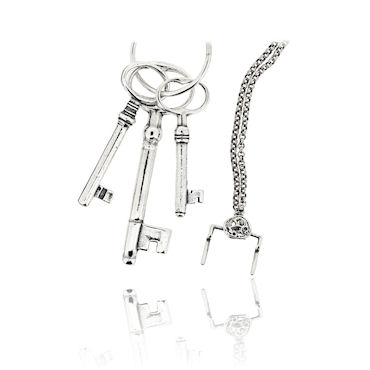What does the Brooch tell us?
The old brooches are not just randomly designed, they were made in a time where few of us could read or write. On the other hand most people understood symbols and the meaning attached to them. This is in great contrast to the present, where most of us can read and write, but few understand symbols unless they are part of orders like Odd Fellow or The Freemasons. Other peoples knowledge of symbols is usually confined to traffic signs and such.
Therefore we will take a step back in history, and reveal the brooches' hidden messages.
In general, you can find symmetry in most of the brooches. And the number of items - like the number of dishes in a dish brooch (Skaalsolje) and Bols in a Bol brooch (Bolesolje) - are often divisible by 3 or 4. An example is 6, 8 or 12 dishes, or 6 curves in the serpent brooch (Slange solje).
This is not just because it's geometrically easier to design. When it's divisible by 3, it refers to the holy trinity; the Father, the Son and the Holy Spirit. When it's divisible by 4 it refers to the 4 "corners" in the world; north, south, east and west. Therefore; it was an appreciation for the whole Creation.
But then again you can find a more specific use of symbolism in the different kinds of brooches:
| Bol Brooch (Bolesolje) In Telemark it was a tradition that girls used the serpent brooch. When she got married she was given a Bol brooch. The Snake brooch was then moved down from its top position on the chest, and the Bol brooch would take its place. Nowadays this tradition is quite unknown, not even the people that tailor the Bunad necessarily know about it. The Bol brooch-symbolism derive from the catholic era in Norway. The middle Bol symbolize Jesus, and the twelve Bols around symbolize the twelve apostles. The tongue-edge around the outer edge of this kind of brooch symbolize The Holy Spirit that encircle all the rest. |
| Barley Ring (Boheradsring /Byggkornring) The pendants that hang from this Barley Ring were supposed to represent- yes you guessed it- barley! Barley symbolizes fertility, and these rings are very feminine in their traditional symbolism. |
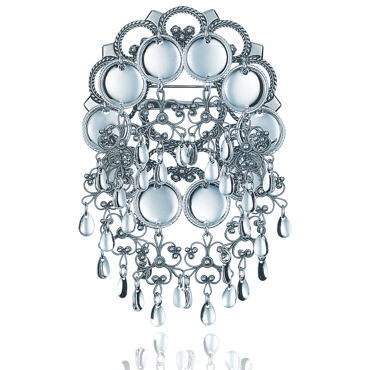
| Dish Brooch (Skaalsolje) Small dishes hanging from the brooch was a common symbol for a girl's virginity. Dish brooches were often used as engagement gifts. The more dishes the brooch had, the more the boy appreciated his girl. (And the more money he had). |
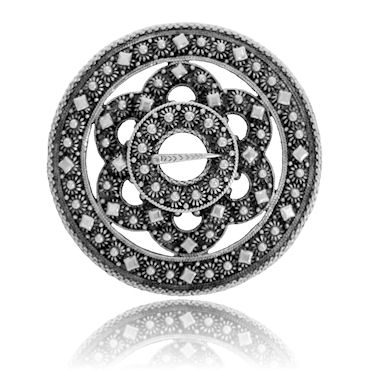
| Serpent Brooch In Telemark it was a tradition that girls used the serpent brooch. When she got married she was given a Bol brooch. The Snake brooch was then moved down from its top position on the chest, and the Bol brooch would take its place. Nowadays this tradition is quite unknown, not even the people that tailor the Bunad necessarily know about it. The symbolism in the serpent filigree brooch is believed to derive from Norse Mythology. It is a sculpture of the Midgaard Serpent, a serpent that lies in a circle along the face of the Earth and bites its own tail. |
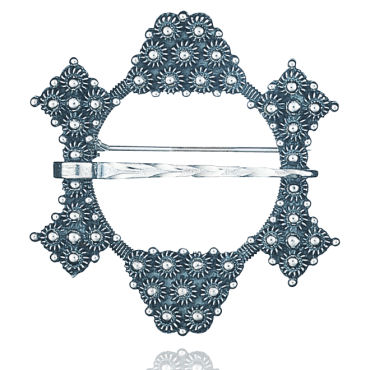
| Horn rings The Horn rings have their name after the horns on each side of the horn pin. They are supposed to look like bull horns, a very masculine symbol. Earlier this was strictly a brooch for men. Now both men and women use it. |
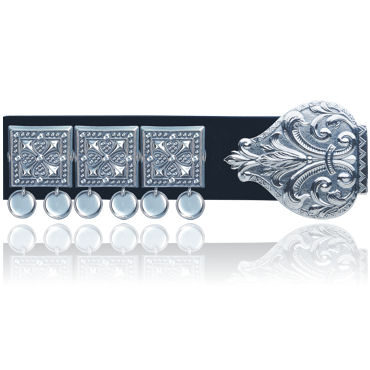
| Plaque belt (Stolebelte) In the old days some Bunads used the plaque belt to separate married and unmarried women. If a woman had a plaque belt she was married. If a woman did not wear a plaque belt she was not married. These days most people don't know about this tradition. Today most people use the plaque belt just as a decorative element. These belts consist of a leather or fabric belt with plaques (stoeler) and a belt buckle connected to it. You can get different types of plaques depending on which Bunad it will be used with. Examples are knife plaques to hang your knife in and purse plaques to hang your purse on. |
| Bore Pins (Borer/Borenaaler) A "Bore" resembles a big button that have an elevated center. They were early used as buckles both for the waist-piece of the Bunad, and on the belt. These days they can be seen on the Bunad purely for decoration. They decorate both the waist piece (Bore needles) and the belt (Borer). |
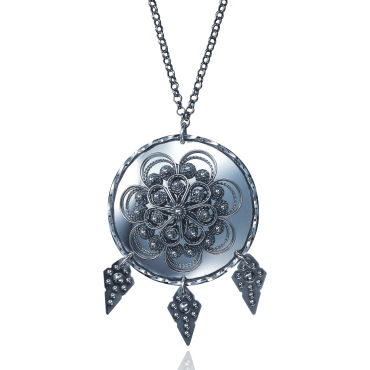
| Agnus Dei, Dalar Agnus Dei is Latin for "Gods lamb". It tells us that the symbolism obviously is Christian. If we look at it in a historic perspective the expression Agnus Dei is based on the gospel (1.29) by the Baptist Johannes, where he mentions Jesus as Gods Lamb. |
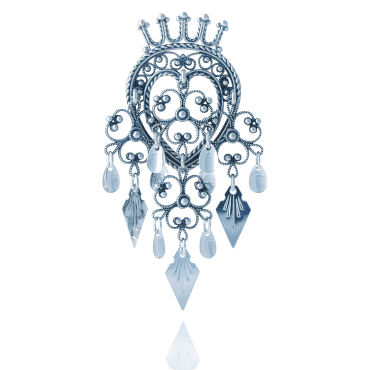
| Heart Brooch (Hjertesolje) Other names for a Heart brooch are "Maria brooch" or "Crown brooch". These brooches symbolize Virgin Mary's (or Mary Magdalena's) pure love, which was crowned with luck. Because of this, the heart brooch is used as a love symbol on the Bunad. |
| Face Brooch (Glibbsolje) This group of brooches contains all brooches with facial- , animal- or figurine motives. These days the name applies to most of the brooches from the west part of Norway (vestlandssøljene). The symbolism in these brooches can be traced back to before Christianity, although the symbols had a certain popularity in the catholic period. The motives used at this time were of Virgin Mary, Jesus or protective mythological creatures. |
| Lady of the house key A key in the belt is not foreign for us. It was so that the lady of the house always carried keys in the belt, because she had the supervision of the farm. The food chambers were always locked, so just the lady of the house had a key. |
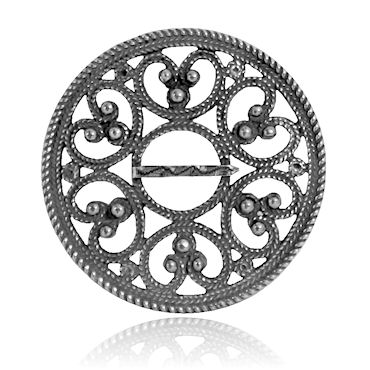 | The Rose Brooch (Rosesolje) The rose brooch has roots back to the 1300's. It has lots of variations. Some will look like the one on the picture, and some will be without the outer ring. Those without the outer ring lack the "frame". The Rose brooch has a form that has stayed like it is from the middle ages. It has 6 open kidney- or heart-shaped figurines connected to form a circle. It is either handmade filigree or casted. |
Return to the frontpage


